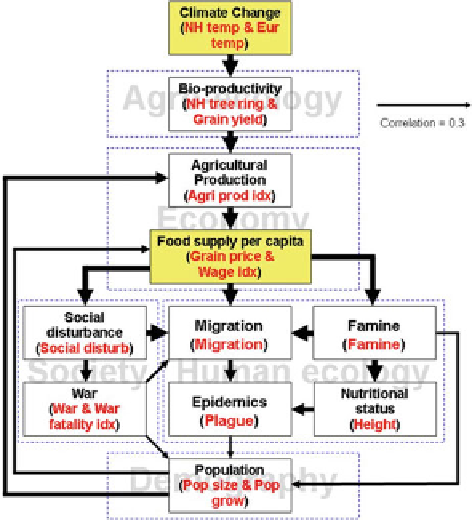Geography Reference
In-Depth Information
cooling in AD 1700 and 1750 caused minor fluctuations in grain yield, real wages,
grain price, famine, war, social disturbance, and migration, its impact was not strong
enough to cause general crisis and population collapse (Fig.
14.6
).
Cooling triggered a chain of responses in variables pertaining to European
physical and human systems. All 16 of the variables we identified are categorized
into 11 sectors according to the response time of variables to cooling, together with
natural laws and social theories related to different variables. Five of these sectors
contain two variables with the same properties (e.g., the variables 'NH temperature'
and 'European temperature' belong to the climate change sector). We then identified
a set of causal linkages among the 11 sectors, demonstrating how climate change
brings about various human crises (Fig.
14.7
).
In the set of causal linkages, climate change and associated bio-productivity
fluctuation are revealed as the ultimate cause of economic, social, human ecological,
and demographic problems. If the climate change and bio-productivity sectors
are disregarded, various linkages within the human system seem to be driven
endogenously by population growth. The concept of a population-driven human
system is prevalent among social scientists, demographers, and economists (Lee and
Anderson
2002
;Turchin
2003
), but ignoring the impact of climate forces on human
systems may lead to false conclusions. Although the causal linkages in Fig.
14.7
are
theoretically reasonable, the time sequence and predictability of the linkages should
be verified statistically before any definite conclusions are drawn.
Fig. 14.7
Set of causal
linkages from climate change
to human crises in
pre-industrial Europe. The
terms in
bold black
type are
sectors, and terms in
red
type
within parentheses are
variables that represent the
sector. The thickness of the
arrow
indicates the degree of
average correlation (Color
figure online)

Search WWH ::

Custom Search